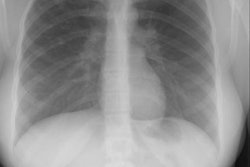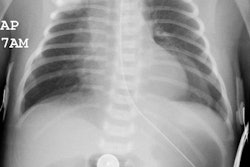Transient Tachypnea of the Newborn (Wet Lung or Retained Fetal Fluid):
View cases of transient tachypnea of the newborn
Clinical:
Transient tachypnea or retained fetal fluid, is felt to be related to poor thoracic squeeze during delivery which results in insufficient clearance of normal pulmonary fluid [1]. This delayed clearance of fetal lung fluid causes transient respiratory distress that improves within 48-72 hours after birth [1]. Predisposing conditions include: C-section, prematurity/precipitous delivery, and maternal diabetes. The incidence of RFF is about 36 cases/1000 infants delviered via c-section prior to the onset of labor and 12 cases/1000 born by c-section after onset of labor, and 5 cases/1000 if born by vaginal delivery [1].Affected neonates demonstrate tachypnea (usually within the first 6 hours of life) with mild cyanosis. Symptoms generally abate over 24-48 hours. Differential considerations include: Meconium aspiration or clear amniotic fluid aspiration, CHF, neonatal pneumonia, respiratory distress syndrome (lung will be HYPOINFLATED), infection with a hemolytic strep. organism (these cases are generally associated with premature membrane rupture and prolonged labor), or pulmonary lymphangiectasia. The affected neonates usually present a little later than those with wet lung).
X-ray:
On CXR the lung volumes are normal to moderately hyperaerated. There are prominent interstitial markings and streaky densities radiating from the hila. "Thickened" fissures can be seen, as can patchy alveolar densities (especially at the bases). Small pleural effusions may be seen.REFERENCES:
(1) AJR 2018; Liszewski MC, Lee EY. Neonatal lung disorders: pattern re to diagnosis. 210: 964-975




